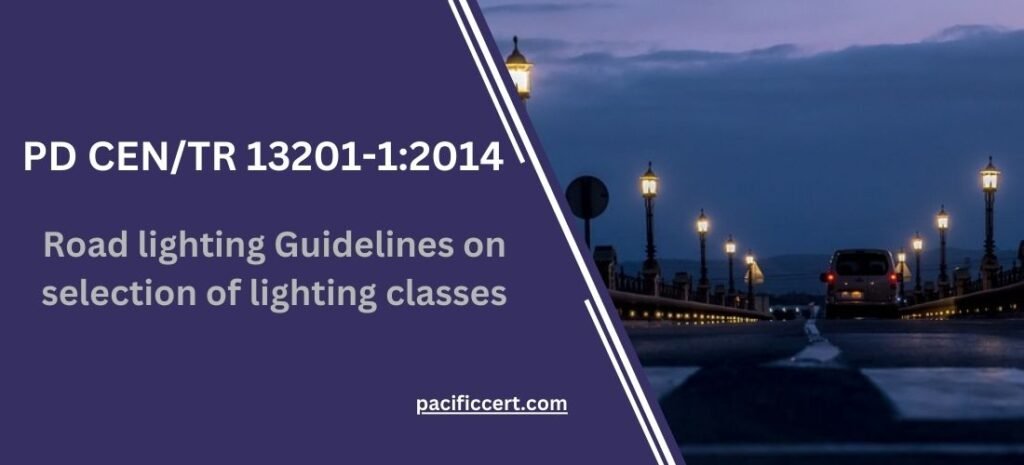
What is PD CEN/TR 13201-1:2014 Road lighting Guidelines on selection of lighting classes?
PD CEN/TR 13201-1:2014 is a technical report that provides guidelines for the selection of lighting classes in road lighting. It is part of the CEN/TR 13201 series, which focuses on road lighting design standards and recommendations.
PD CEN/TR 13201-1:2014 offers guidance on selecting appropriate lighting classes based on the requirements of a road or lighting installation. The lighting classes defined in this technical report are intended to ensure appropriate levels of visibility, comfort, and safety for road users.
Key aspects covered in PD CEN/TR 13201-1:2014 include:
Road Lighting Parameters: The report outlines various parameters that influence the selection of lighting classes. Such as road type, traffic flow, road geometry, presence of pedestrians or cyclists, and surrounding environmental conditions.
Lighting Classes: EN 13201-1:2014 defines a range of lighting classes, typically denoted as S classes, which represent different levels of lighting performance. Each lighting class corresponds to specific minimum levels of illuminance (lighting level) and uniformity requirements.
Selection Criteria: The technical report provides criteria to help determine the appropriate lighting class for a given road or lighting installation. These criteria consider factors such as the type of road, speed limits, traffic volumes, road user needs, and the presence of vulnerable road users.
Calculation Methods: This standard offers guidance on calculation methods for determining illuminance levels and uniformity requirements based on the selected lighting class. So, This includes recommendations for measurement points, calculation zones, and evaluation methods.
Light Distribution: The report addresses the importance of considering the appropriate light distribution for different road categories. It provides guidance on selecting lighting equipment. Such as luminaires and light sources, to achieve the desired lighting class requirements.
PD CEN/TR 13201-1:2014 is a technical report and not a standard. Therefore, it provides guidance and recommendations rather than mandatory requirements.
What is BS EN 13201-2:2015 Road lighting Performance requirements?
BS EN 13201-2:2015 specifies performance requirements for road lighting installations. It is part of the EN 13201 series, which provides standards and guidelines for road lighting design and assessment.
BS EN 13201-2:2015 focuses specifically on the performance requirements for road lighting. It establishes criteria and measurements related to lighting performance. Including illuminance, luminance, and uniformity. Therefore, The standard aims to ensure adequate lighting levels, visual comfort, and safety for road users.
Key aspects covered in BS EN 13201-2 include:
Performance Parameters: The standard defines various performance parameters that are important for road lighting installations. These parameters include average luminance, uniformity ratio, longitudinal luminance distribution, glare restriction, color appearance, and flicker.
Lighting Classes: BS EN 13201-2 introduces a range of lighting classes, denoted by the letter “C,” which represent different levels of lighting performance. Each lighting class corresponds to specific requirements for illuminance, uniformity, and other performance parameters.
Calculation Methods: The standard provides calculation methods for determining the lighting performance parameters based on the selected lighting class. So,These methods consider factors such as road category, traffic conditions, road user needs, and the presence of pedestrians or cyclists.
Measurement and Assessment: BS EN 13201-2 outlines procedures for measuring and assessing the lighting performance of road lighting installations. It includes guidance on measurement locations, equipment requirements, data collection, and interpretation of measurement results.
Verification and Compliance: The standard specifies the criteria for verifying compliance with the performance requirements. It establishes tolerances and limits for each performance parameter, enabling the evaluation of lighting installations against the specified lighting classes.
What is BS EN 13201-4:2015 Road lighting Methods of measuring lighting performance?
BS EN 13201-4:2015 provides guidelines and methods for measuring the lighting performance of road lighting installations. Thus, It focuses on the measurement procedures and techniques to assess various lighting parameters to ensure compliance with performance requirements.
Key aspects covered in BS EN 13201-4:2015 include:
Measurement Parameters: The standard specifies the parameters to be measured to evaluate the lighting performance of road lighting installations. These parameters include illuminance, luminance, and uniformity.
Measurement Equipment: This standard outlines the requirements for measurement equipment used in assessing lighting performance. It covers instruments such as luminance meters, illuminance meters, and other relevant devices necessary for accurate measurements.
Measurement Locations: BS EN 13201-4:2015 provides guidance on selecting appropriate measurement locations along roadways to ensure representative and reliable measurement results. It considers factors such as road geometry, traffic conditions, and relevant lighting classes.
Measurement Procedures: This standard describes the step-by-step procedures for conducting measurements of lighting parameters. Thus, It includes guidance on the positioning of measurement devices, the number of measurement points, measurement duration, and data collection techniques.
Data Analysis: BS EN 13201-4:2015 addresses the analysis and interpretation of measurement data obtained during lighting performance assessments. Therefore, It provides guidance on calculating average values, assessing uniformity, and comparing results against the requirements of the specific lighting class.
Reporting: The standard includes recommendations for reporting measurement results. It specifies the information to be included in measurement reports. Such as measurement locations, values obtained, and any additional relevant details.
BS EN 13201-4:2015 aims to ensure consistent and accurate measurement of lighting performance for road lighting installations. Thus, It provides a standardized approach to assess lighting parameters, enabling comparisons and evaluations across different installations.
Requirements of BS EN 13201-1-Road lighting Road lighting
Road Classification: The standard defines different road categories based on factors. Such as function, traffic volume, and road geometry. It provides specific requirements and recommendations for each road category.
Lighting Classes: BS EN 13201-1:2015 introduces a range of lighting classes, denoted by the letter “S,” which represent different levels of lighting performance. Each lighting class corresponds to specific requirements for illuminance, uniformity, and other performance parameters.
Parameters for Lighting Design: The standard specifies parameters such as the minimum and average horizontal illuminance, uniformity ratio, vertical illuminance, and luminance distribution. In fact, These parameters help ensure adequate lighting levels and visual comfort for road users.
Environmental Factors: BS EN 13201-1:2015 takes into account various environmental factors that may influence road lighting design. So, these factors include the presence of pedestrians or cyclists, the surrounding environment, weather conditions, and potential light pollution.
Energy Efficiency: The standard encourages the use of energy-efficient lighting solutions. Also, recommends the consideration of energy consumption and carbon footprint in road lighting design.
Measurement and Verification: BS EN 13201-1 provides guidance on measurement methods and verification procedures to assess compliance with the specified lighting classes and requirements. Therefore, It includes recommendations for measurement points, calculation zones, and evaluation methods.
Documentation and Reporting: This standard emphasizes the importance of documenting the road lighting design process, including the selection of lighting classes, calculations, and measurements. It also provides recommendations for reporting the lighting design parameters and results.
Therefore, This standard serves as a reference for road lighting professionals, designers, and authorities involved in the design and implementation of road lighting installations. It ensures that road lighting is designed to meet appropriate lighting standards, promoting visibility, safety, and visual comfort for road users.
Benefits of BS EN 13201-1-Road lighting
Standardization: BS EN 13201-1 provides a standardized approach to road lighting design. By following the requirements and recommendations of the standard, consistency and uniformity can be achieved in road lighting installations across different locations and jurisdictions.
Improved Visibility and Safety: This standards aims to ensure adequate lighting levels and uniformity on roadways. By meeting these requirements, road users can benefit from improved visibility, allowing for better recognition of objects, pedestrians, and potential hazards. This can enhance overall road safety for both drivers and pedestrians.
Visual Comfort: The standard addresses parameters such as luminance distribution and glare control. By considering these factors, road lighting installations can provide a more visually comfortable environment for road users, reducing discomfort, eyestrain, and potential visual distractions.
Energy Efficiency: The standard encourages the use of energy-efficient lighting solutions. By considering energy consumption and optimization in road lighting design, it promotes sustainability and helps reduce energy costs and environmental impact.
Compliance and Legal Requirements: Adhering to BS EN 13201-1 ensures compliance with European lighting standards and may be required by local regulations and authorities. Meeting the requirements of the standard helps demonstrate due diligence and compliance with industry best practices, reducing the risk of legal or regulatory issues.
Consistency in Documentation and Reporting: The standard emphasizes documenting the road lighting design process and reporting the lighting parameters and results. This promotes transparency, facilitates communication between stakeholders, and ensures a clear record of the design decisions and compliance with the standard.
Professional Credibility: Following recognized standards like BS EN 13201-1 enhances the professional credibility of road lighting designers and professionals. It demonstrates a commitment to quality, safety, and adherence to industry best practices, which can be advantageous for professional reputation and business competitiveness.
Pacific Certifications is accredited by ABIS, if you need more support with BS EN 13201-1, please contact us at +91-8595603096 or support@pacificcert.com
Read About: DIN EN 1090-1- Execution of steel structures and aluminium structures







